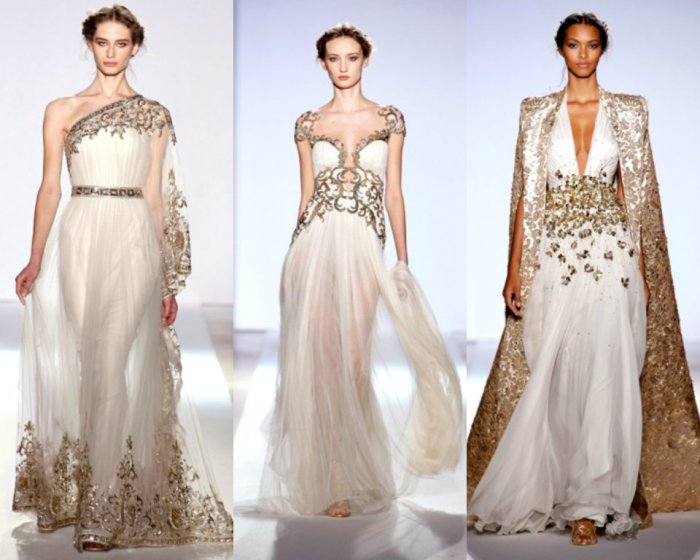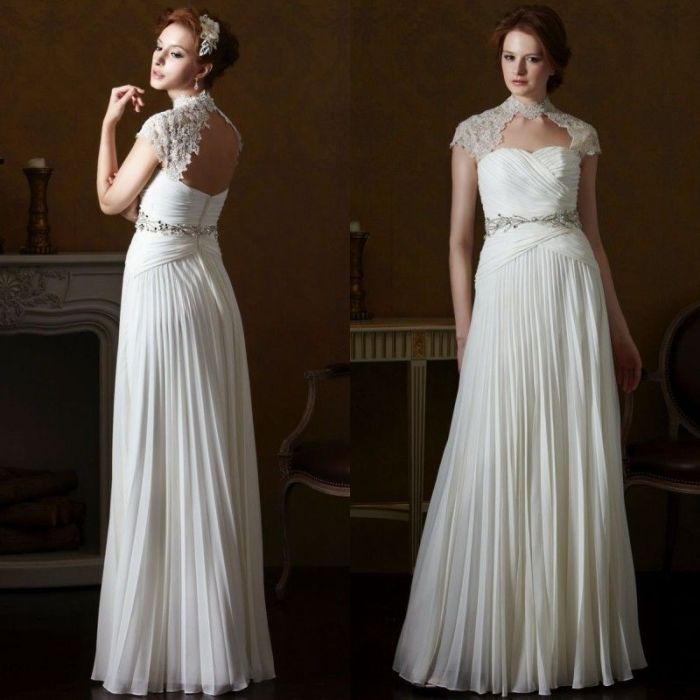Greek Goddess Style Wedding Dresses
Defining “Greek Goddess Style” in Wedding Dresses: Greek Goddess Style Wedding Dresses

Source: emasscraft.org
Greek goddess style wedding dresses – The Greek goddess style in wedding dresses evokes a sense of ethereal beauty, timeless elegance, and effortless grace. This style draws inspiration from ancient Greek art and sculpture, emphasizing flowing fabrics, simple silhouettes, and a focus on natural beauty.
Key Characteristics of Greek Goddess Style Wedding Dresses
Key characteristics include flowing fabrics like silk chiffon or georgette, often in ivory, white, or soft pastel shades. Silhouettes typically feature an empire waistline, emphasizing the natural curves of the body, or a flowing A-line shape. The overall aesthetic is one of understated elegance, with minimal embellishment and a focus on the drape and movement of the fabric.
Historical Influences and Evolution
The style’s roots lie in ancient Greek art, specifically the depiction of goddesses in flowing robes. Over time, the style has evolved, incorporating modern design elements while retaining its core aesthetic. Early 20th-century designers adapted classical themes, and the style experienced a resurgence in popularity in the late 20th and early 21st centuries, with designers offering contemporary interpretations.
Comparison with Other Bridal Styles
Compared to bohemian styles, which often feature intricate lace and embroidery, Greek goddess dresses are simpler and more minimalist. Unlike princess-style gowns with voluminous skirts and structured bodices, Greek goddess dresses emphasize fluidity and natural movement. The romantic aesthetic shares similarities with bohemian styles but distinguishes itself through its clean lines and classical inspiration.
Visual Representation of a Typical Greek Goddess Wedding Dress
Imagine a flowing ivory silk chiffon gown with an empire waistline that skims the body gracefully. The fabric drapes effortlessly, creating soft folds and movement. The neckline is simple, perhaps a halter neck or a delicate sweetheart neckline. The sleeves, if any, are often off-the-shoulder or cap sleeves, adding a touch of elegance. The overall effect is one of ethereal beauty and understated sophistication.
Fabrics and Silhouettes
The choice of fabric and silhouette significantly impacts the overall look and feel of a Greek goddess wedding dress. Understanding these elements is crucial for achieving the desired aesthetic.
Dreaming of a Greek goddess wedding? Imagine flowing fabrics, ethereal silhouettes, and a touch of celestial shimmer. For a truly radiant look, consider adding a dazzling touch of gold; perhaps a gold sequin wedding dress could be the perfect way to capture that divine sparkle, enhancing the majestic feel of your Grecian-inspired gown. The result? A wedding look that’s both timeless and unforgettable.
Commonly Used Fabrics
Lightweight, flowing fabrics are key. Silk chiffon, georgette, crepe, and charmeuse are popular choices due to their drape and ability to create a sense of movement. These fabrics create the ethereal and flowing look associated with the style. Heavier fabrics would detract from the intended fluidity.
Typical Silhouettes
Empire waist, A-line, and flowing column silhouettes are commonly associated with this style. The empire waist accentuates the bust and flows loosely over the rest of the body. The A-line offers a more structured but still flowing look. The column silhouette is a more sleek and form-fitting option, still maintaining the grace of the style.
Three Different Silhouette Designs
- Empire Waist Gown: A flowing gown with a high waistline that sits just below the bust, creating a long, flowing skirt. The bodice is typically fitted, emphasizing the upper body.
- A-Line Gown: A more structured silhouette that flares gently from the waist, creating a balanced and flattering look. The skirt maintains a sense of flow and movement.
- Column Gown: A sleek and simple silhouette that skims the body without clinging too tightly. This option emphasizes a more modern interpretation of the classic style.
Impact of Fabrics on Overall Look
Lightweight fabrics like chiffon create a delicate and ethereal look, while heavier fabrics like crepe offer a more structured and sophisticated feel. The choice of fabric directly influences the overall drape and movement of the dress.
Accessories and Details
Accessories play a crucial role in completing the Greek goddess look, adding subtle details that enhance the overall aesthetic. The right accessories can elevate the simple elegance of the dress.
Role of Accessories
Accessories such as headpieces, jewelry, and veils add a touch of sophistication and enhance the overall look. They should complement the dress without overwhelming it. Simple, elegant pieces are preferred to maintain the overall minimalist feel.
Appropriate Hairstyles
Loose, flowing hairstyles that frame the face beautifully are ideal. Braids, updos with loose tendrils, and wavy hair are all excellent choices. The hairstyle should complement the ethereal nature of the dress.
Use of Embellishments
Embellishments are typically minimal. Delicate embroidery, subtle beading, or strategically placed draping can add texture and visual interest without detracting from the dress’s simple elegance. Overly ornate embellishments would clash with the minimalist aesthetic.
Accessory Table, Greek goddess style wedding dresses
| Accessory Type | Material | Description | Effect on Overall Look |
|---|---|---|---|
| Headpiece | Gold leaf, pearls | A delicate circlet or a simple hair vine | Adds a touch of ethereal elegance |
| Jewelry | Gold, pearls | Simple necklaces, earrings, and bracelets | Complements the minimalist aesthetic |
| Veil | Silk chiffon | A flowing, lightweight veil | Adds a touch of romance and drama |
| Shoes | Satin, leather | Simple sandals or heels in neutral tones | Completes the overall look without being distracting |
Modern Interpretations
Contemporary designers continue to reinterpret the classic Greek goddess style, blending traditional elements with modern sensibilities. This results in unique and stylish wedding dresses that honor the past while embracing current trends.
Traditional vs. Modern Adaptations

Source: dhresource.com
Traditional Greek goddess dresses are typically characterized by simple silhouettes and flowing fabrics. Modern adaptations might incorporate more fitted bodices, unique necklines, or subtle embellishments while still retaining the core elements of the style.
Incorporating Modern Elements
Modern elements can be incorporated subtly. A bold color, a unique neckline (like a plunging V-neck or a high halter neck), or sleeves (such as long, flowing sleeves or even short, puffed sleeves) can add a modern twist without compromising the essence of the style.
Five Modern Twists
- Asymmetrical Hemline: A modern twist on the traditional flowing skirt, adding a contemporary edge.
- Statement Sleeves: Incorporating dramatic sleeves, like bell sleeves or bishop sleeves, adds a modern flair.
- Detailed Back: A simple front with intricate detailing on the back provides a surprising and stylish element.
- Unique Neckline: A modern neckline, such as a square neck or a plunging V-neck, can modernize the look.
- Subtle Embellishments: Strategic placement of delicate embroidery or beading adds texture and interest without overwhelming the simplicity.
Makeup and Styling
The makeup and hairstyle should complement the ethereal beauty of the Greek goddess wedding dress, enhancing the overall aesthetic. A natural and radiant look is preferred.
Makeup Look
A natural and radiant makeup look is ideal, emphasizing the eyes and creating a glowing complexion. A neutral color palette with soft pinks, peaches, and browns is appropriate. The focus should be on enhancing natural features, creating a fresh and radiant look.
Color Palettes and Techniques
Soft, natural shades are key. Think peachy blushes, bronze or gold eyeshadows, and nude or rosy lipsticks. Contouring should be subtle, focusing on creating a natural, sculpted look. The overall goal is a flawless, radiant complexion that complements the dress.
Hairstyles
Loose, flowing hairstyles, such as braids, low buns with loose tendrils, or wavy hair, complement the ethereal nature of the dress. The hair should frame the face beautifully, creating a romantic and elegant look.
Step-by-Step Makeup Guide
- Start with a hydrating primer to create a smooth base.
- Apply a lightweight foundation for a natural finish.
- Use a peachy blush on the apples of your cheeks.
- Apply a bronze or gold eyeshadow to the eyelids.
- Line your eyes with a brown eyeliner.
- Apply mascara to your lashes.
- Finish with a nude or rosy lipstick.
Questions and Answers
What is the best season to wear a Greek Goddess style wedding dress?
The flowing fabrics of a Greek goddess dress make it ideal for warmer months like spring or summer. However, with the right layering, it can be adapted for cooler seasons as well.
Can I wear a Greek Goddess style dress if I’m not traditionally “slim”?
Absolutely! The draping and flowing nature of these dresses are incredibly flattering on various body types. The right silhouette can beautifully accentuate your figure.
How much does a Greek Goddess style wedding dress typically cost?
Prices vary widely depending on designer, fabric, and embellishments. You can find options ranging from affordable to high-end luxury.
Where can I find a Greek Goddess style wedding dress?
Many bridal boutiques carry dresses inspired by this style. You can also explore online retailers specializing in bridal wear or even commission a custom-made gown.



















